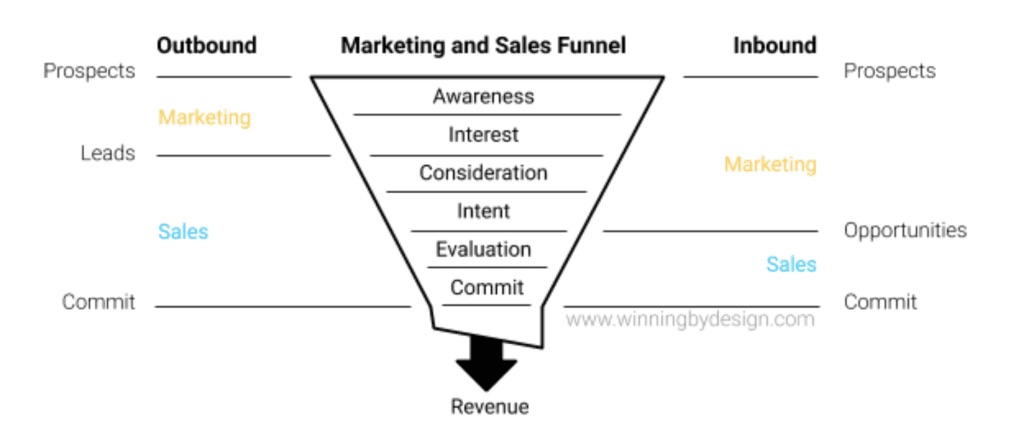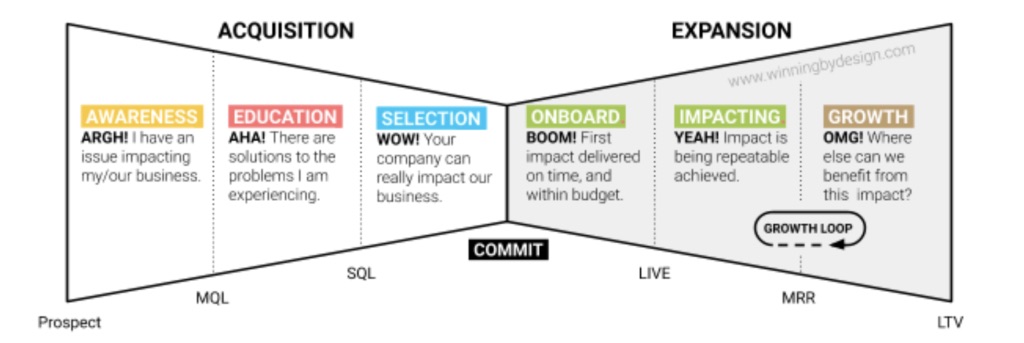
. It’s further complicated by the fact that these roles are still being reinvented as SaaS orgs evolve along with the new technology they are using to power their teams.
Let’s review how to make sense of these roles: we’ll go through how we should think about these stages, and how to define roles and responsibilities across each stage. Teams may have slight variations depending on your business model, but these principles should apply across the board as you are defining your go to market organization.
.
In 1898, Elias St. Elmo Lewis developed a model that mapped a theoretical customer journey from the moment a brand or product attracted consumer attention to the point of action or purchase. He created a four-stage process: Awareness, Interest, Desire, and Action (AIDA). This term was made popular when it was famously enacted by Alec Baldwin in the cult classic film Glengarry Glen Ross. In the AIDA model, revenue and profits are realized shortly after the client signs a contract. Many sales and marketing organizations still are based on a version of AIDA, which today is referred to as “the funnel”.

Figure 1. The Marketing & Sales Funnel, evolved from AIDA
With the advent of recurring revenue models, the conventional layered funnel depicted above became outdated – because it was designed from the seller’s perspective, not the buyer’s. To further complicate things, it created a siloed approach in which individual teams focused on their own narrow performance metrics at the expense of others in order to hit their targets.

Figure 2. Bowtie model with stages based on customer experiences
We visualize this new model as a ‘bowtie.’ The bowtie must cover two critical gaps: 1) the impact stage where sellers must ensure that customers achieve their expected impact; and 2) the critical activity of growing the business together with your customer. These two additional stages create a compound growth loop. In comparison, a funnel model was designed to achieve linear growth without a growth loop.
As described in the book The SaaS Sales Method: Sales as a Science, a high-velocity business must operate as a system. This means that departments must operate with each other flawlessly, and not as siloes.
What this means is that every team has a role in each stage of the sales funnel; the amount of involvement of course varies in each stage. For example, Marketing must be involved throughout the entire sales process – not only in the awareness stage. And Customer Success should be involved before the customer commits, if you want to have a successful handoff from sales to CS and a great experience for the customer.
The exact levels of involvement will vary from business to business; you should determine how each department needs to be involved at each stage, and with what kind of action.
The degree of specialization that you should have in your organization is generally a function of the Annual Contract Value (ACV). For example, at a lower ACV of $2,500/year, you would likely have a full inbound funnel with an online credit card transaction. Compare this to higher ACVs, say $50,000, may involve a response to a request for a proposal, discovery calls, and even a proof of concept.
This specialization is in response to what the customer values. At a lower ACV, customers value a seamless working product operating in a standard workspace (think of a Google Chrome plug-in). At higher ACVs, they value a high-touch service that helps with deep integration into the customized environment (think of a sales automation platform).